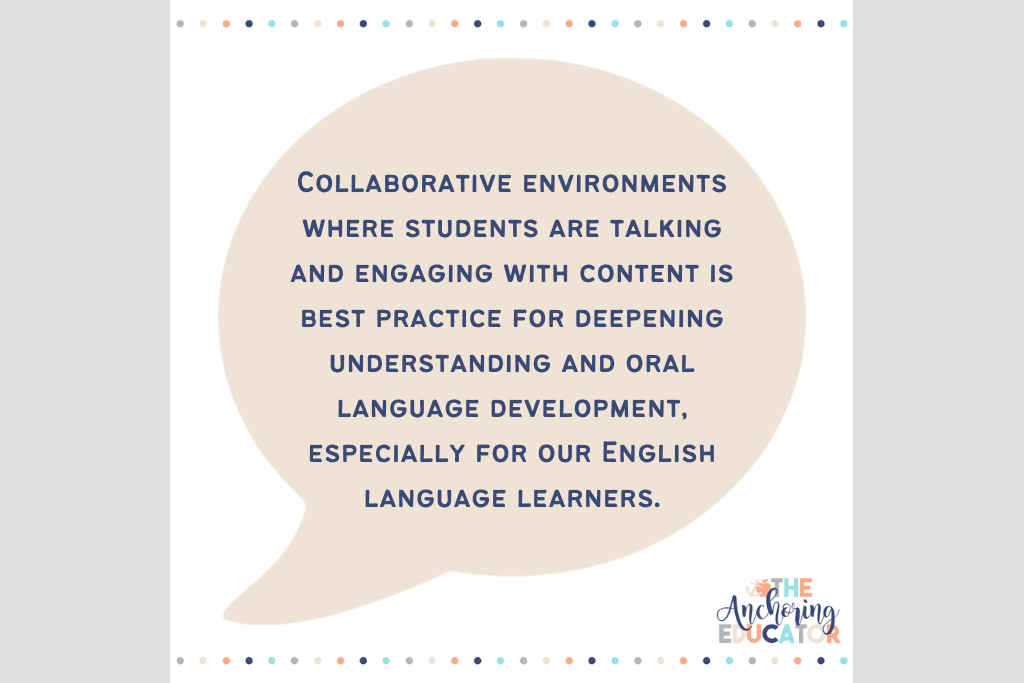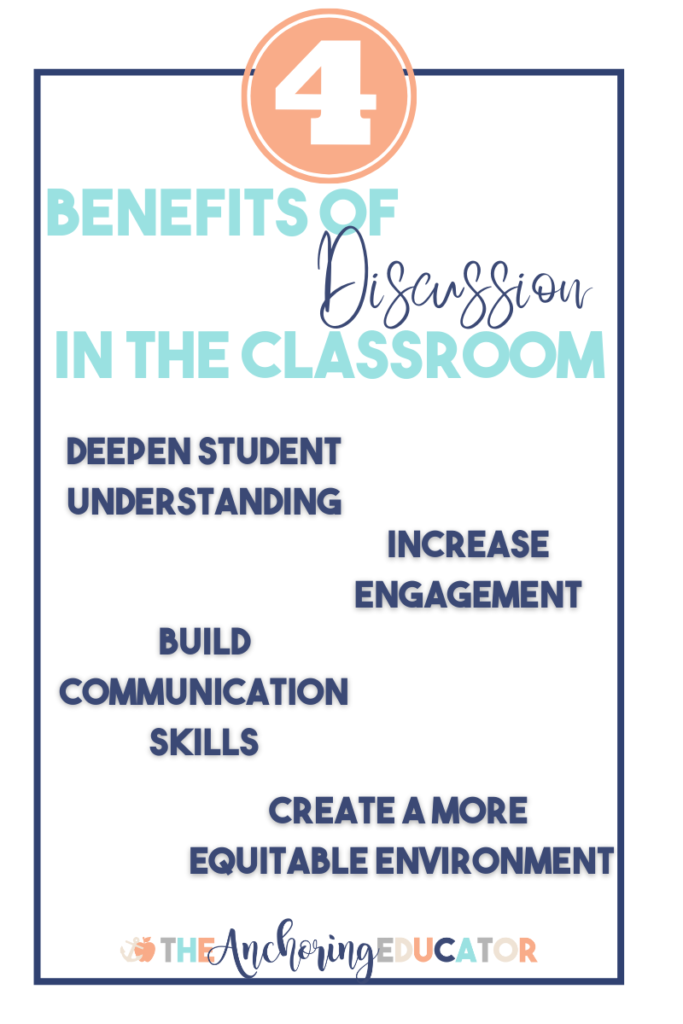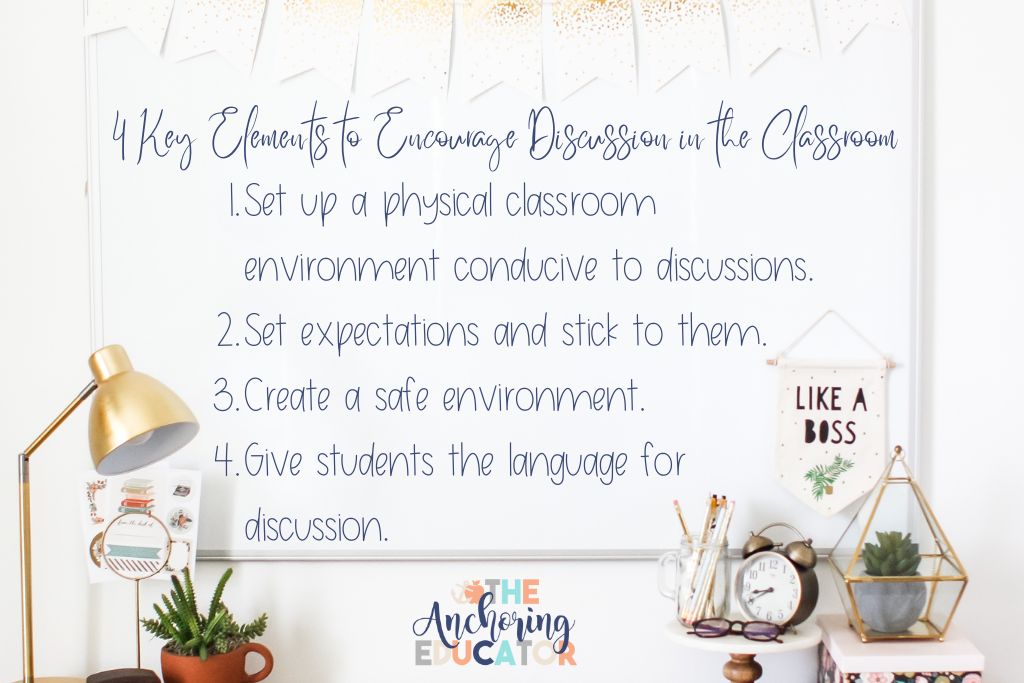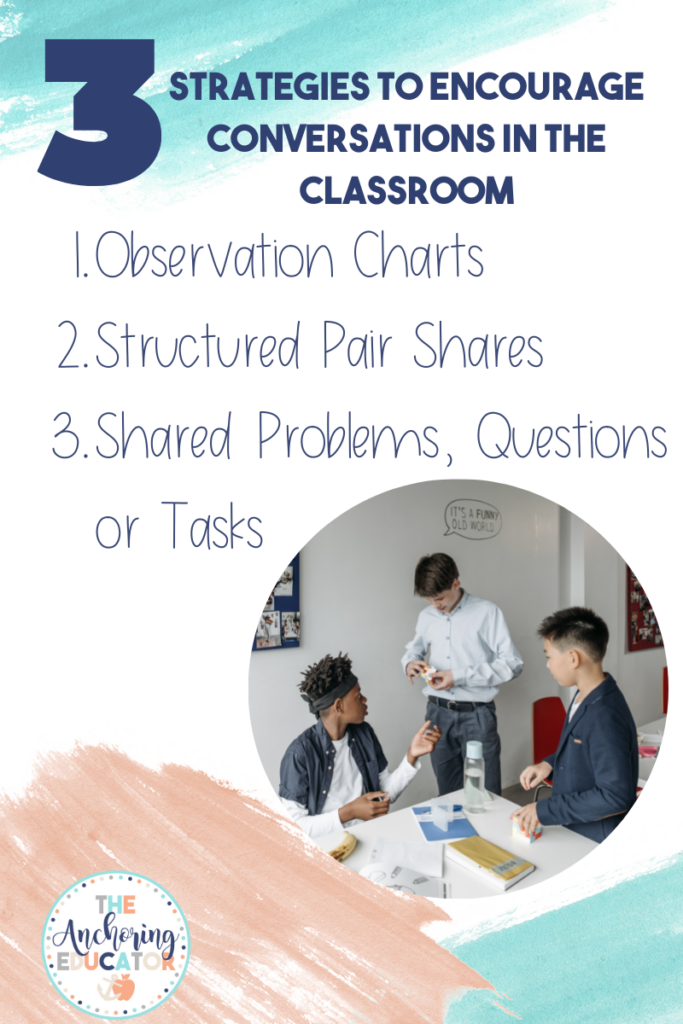Are you looking for strategies to promote academic discussions in the classroom? Then keep on readin’! During my ninth year in education, I finally learned three strategies that work like charm. I know what you might be thinking… but will their conversations in the classroom actually stay on topic? Will they all be engaged? Will they be speaking and actually listening to each other? YES. YES. And MORE YES. TALK ABOUT A TEACHER’S DREAM.
We want to encourage productive discussions in our classrooms. Collaborative environments where students are talking and engaging with content are best practice for deepening understanding and oral language development, especially for our English language learners. If we’ve learned anything in education, it’s that a silent classroom with students sitting in rows, facing forward, and students working independently 100% of the day are a thing of the past. If this is currently what your classroom looks like, don’t be discouraged. We’ve all been there. We were all once told that we have excellent classroom management skills if students are working quietly and on task. These days are no more! Keep on reading for the benefits and strategies to build a classroom environment that will help you promote discussions in the classroom.

Benefits of Discussion in the Classroom
So why are class discussions important and how do they benefit students?
It deepens students’ understanding of the content.
When students are talking about the content, they are using the vocabulary and summarizing what they’ve learned which helps them remember the information. They also become more metacognitive, meaning that they are more aware of what they know and the areas in which they still need support.
It increases student engagement.
Learning is more fun when you are engaged in the content. There is more buy-in from students. When they engage in conversations about the topic, it motivates them to keep learning more. It builds confidence and a positive learning community in the classroom.
It builds communication skills.
The more students have opportunities to speak to others, the more they are able to learn communication skills that will last them a lifetime. When discussion in the classroom is happening, students are learning how to communicate with various personalities, listen to perspectives that might be different from their own, and learn how to work with and collaborate with others to reach a shared goal. As teachers, we KNOW how valuable great collaboration can be to a successful career.
It helps create a more equitable environment.
Research has shown that discussions in the classroom are linked to higher literacy skills, especially for English language learners. Giving students opportunities to practice language in the classroom is crucial to their language development. In addition, when all students are required to participate, then they are all active learners and no one falls through the cracks. Newcomers, or students who are new to the United States, and do not yet speak English, can speak in their native language, giving them the opportunity to still process the content, feel included in the classroom environment and the task at hand, and build confidence.

4 Key Elements to Encourage Discussion in the Classroom
Set up a physical classroom environment conducive to discussions.
Set up your desks in groups of 3-4 students. When students are sitting on the carpet, partner them up. You can have the teams of 3-4 students sitting next to each other on the carpet and pair them up from there, or they can have a completely different partner on the carpet. This is up to you as the teacher. Keep these same groups and partners for an entire unit of study, or about a month. I highly discourage making any student an “island.” Yes, the one that just is always chatting up their teammates. There is nowhere you can move them, an island is your only choice. I know, we’ve all been there and we’ve all done it. However, this can have a negative impact on the student. This can include lowering confidence, carrying labels, such as the student that “talks too much” or is “always in trouble” from peers, lowering engagement and love for learning, etc… Instead, focus on how their strong communication skills can benefit them in the long run or in their groups. Teach them how to utilize their talking skills productively. Who knows, maybe one day they will be in sales!
Set expectations and stick to them.
Begin with a t-chart on collaboration. Be explicit about what that looks like and sounds like in your classroom. Review this chart before and after group discussions & group work. If you’d like to read more about creating a t-chart, click here to read all about how to implement this chart on my blog and get the free resource to support you here.
Create a safe environment.
Students need to be able to feel vulnerable during these discussions. They need to be able to practice their English skills and practice new vocabulary and content just learned. They need to be able to feel like they can make mistakes. When students share about themselves, their experiences and their backgrounds, you promote cultural awareness and a safe environment. Click here to read more about this on my blog. If you need resources, check out these two activities I’ve created: All About My Name and All About My Culture, or get the bundle at a discount here.
Give students the language for discussion.
It needs to be explicitly taught that there is specific language we use for specific audiences and task types. If they are comparing, give them that language for comparing, if they are debating, give them that language for debate. Then, practice, practice, practice. Give students ample opportunities to practice using this language with each other. My Accountable Talk Resource Cards can support you in getting started if you need help.

3 Strategies to Encourage Conversations in the Classroom
Observation Charts
Students work in pairs to write/draw an observation, make a prediction and ask a question about photographs that are related to the current unit of study. Click here to read all the details on this strategy and get the resource here.
Structured Pair Share Strategy
The teacher gives students time to speak to a partner in order to digest the content throughout the lesson. We as teachers need to ensure we have a structured routine and a clear target for students. We want students to be experts in the expectation and routines so that we maximize instructional and learning time. Read more about this strategy on my blog: 5 Simple Steps to Help You Use the Pair Sharing Strategy Effectively.
Shared Problem, Question, or Task
Give students a shared problem, question, or task with clear expectations. Students hold themselves and each other accountable for 100% group participation. Then, give students a large piece of white paper (construction paper, posters, chart paper). The expectation is that they work on the task at hand as a team. Some examples of shared work can include planning/drafting their idea for a STEM challenge, recopying an anchor chart or applying new learning to create their own anchor chart, the problem of the day in math, etc…

Helpful Articles and Resources to Further Support You
Articles & Blogs
- Edutopia: Talking to Learn: Harnessing the Power of Student Conversation
- Yale: Effective Classroom Discussions
- 2 Fun and Engaging Cultural Diversity Activities to Use in Your Classroom
- 1 Simple Strategy to Get Your Students Talking and Excited About Learning
- How to Launch Collaborative Groups to Get All Students Learning
- Promote Academic Vocabulary With This Effective Classroom Management Strategy
- 5 Simple Steps to Help You Use the Pair Sharing Strategy Effectively
Resources
- Implement Start/Stop Signal with High-Level Vocabulary (free resource)
- Give Students the language for discussion: Accountable Talk Resource Cards
- Observation Charts
- Build a Safe Classroom Environment: All About My Name, All About My Culture, Bundle (both resources at a discount)
- Team Task Key (free resource)
I really hope that this information helps promote discussions in the classroom. Remember to give yourself and your students time and space to adapt to this new dynamic. If you have any questions or would like more information on anything, please leave a comment below! I love connecting with you as much as possible and providing you with continued support!
